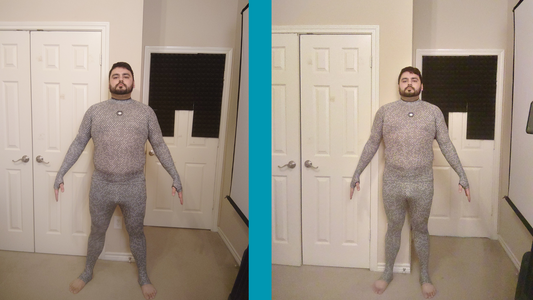

What Body Parts Should You Measure for Weight Loss?
Whether you are new to weight loss or an old hand, you probably think of the bathroom scale as the best way to track your progress. However, because changes in weight are not always an accurate reflection of what is actually changing in your body, it can be helpful to incorporate other tracking methods, such as taking body measurements with ZOZOFIT.
So, what body parts do you measure for weight loss? Let's take a look.
What Body Parts Do You Measure for Weight Loss?
Everyone loses weight a bit differently. You have probably heard that you cannot spot-reduce. This means that even if what you most want is smaller thighs, you cannot control which parts of your body shrink first when you lose weight. Usually, the last part of your body where you gained weight will be the first where you will lose it. However, in general, you will probably lose some weight all over, rather than one part at a time.
For this reason, it is most helpful to take whole-body measurements, rather than to focus on specific body parts. The body parts that people most commonly measure are:
- Waist
- Hips
- Chest
- Upper arms
- Thighs
- Neck
Some people may also measure their forearms and calves.
How Often Should You Measure Your Body Parts To Get the Most Accurate Results?
Experts advise against measuring yourself every day. Your body measurements are not likely to change much from day to day, and measuring too often could be demotivating. Instead, track your measurements about once every two weeks.
What Should Your Body Measurements Be?
There is no one ideal measurement for your body parts. However, medical professionals use some guidelines to screen for certain health conditions. For example, researchers have found a correlation between waist circumference and your risk for heart disease or Type 2 diabetes.
If you are a woman with a waist circumference that exceeds 35 inches or a man with a waist circumference above 40 inches, you may have a higher risk. If you have concerns about your risk factors, talk to your doctor.
How Can You Take Your Body Measurements?
The most common method of measuring body parts is to use a flexible measuring tape, such as those that tailors use to measure people for clothing. However, this method can be cumbersome and inaccurate.
Trying to wrap a measuring tape around the same spot on each body part and then accurately read the number can be difficult, particularly if you do not have someone to help you. This may make it difficult to track your progress because changes in measurements may have more to do with where you placed the tape than with how your body is changing.
ZOZOFIT's body scanning app solves this problem by automatically and precisely tracking changes in your body composition and measurements by utilizing 3D images to visualize your progress. All you need to do is use our smartphone app to scan your body.
The app automatically records your measurements and can even send them to your coach, trainer, or support community. With ZOZOFIT, taking your body measurements is easier than ever.
How Can You Keep Track of Your Body Measurements for Weight Loss?
If you are taking your body measurements the old-fashioned way, you must meticulously record them in a spreadsheet or smartphone app, or with a pencil and paper. When you use ZOZOFIT, our smartphone app automatically records your measurements and other data so you do not need to take additional steps to keep track of them or see how your body is changing.
What Are the Benefits of Tracking Your Body Measurements for Weight Loss?
The number you see when you step on the bathroom scale includes the weight of your muscles, bones, internal organs, skin, adipose tissue, tendons, blood, and the contents of your stomach, bladder, and intestines. Even your hair and fingernails contribute a little. When people say they want to lose weight, what they usually mean is that they want to change their body composition, usually by reducing their adipose tissue.
When people "go on a diet" or attempt to lose weight by exercising more, they may lose a combination of water, muscle, and body fat. Simply stepping on a bathroom scale does not give you a very good indication of what is causing the changes in the number you see.
Measuring your body parts is one way to judge how much your body composition is changing. As you lose fat, your body parts will tend to get smaller. As a result, even if your body weight does not change or goes up because of changes in your muscle or water weight, you can still track whether you are losing fat. This is beneficial in two ways.
Motivational
Watching your scale weight go up or stay the same even though you have faithfully stuck to your routine can be demotivating. Accurately tracking how your body composition is changing, like when you use the ZOZOSUIT and ZOZOFIT app, can help you stay motivated when stepping on the scale may make you want to give up.
Easy and Affordable
There are many ways to estimate changes in your body composition. Some methods, such as skinfold calipers, require specialized skills to get an accurate measurement. Other methods, such as DXA scans, require you to pay expensive testing fees.
You do not need any specialized training or expensive equipment to take your body measurements. The only things you need for your ZOZOFIT measurements are a compatible smartphone and our app (Android users will need their own ZOZOSUIT).
How Can You Improve Your Body Composition?
Improvement is a subjective term. For some people, this may mean gaining muscle. For others, it may mean losing fat. If fat loss is your goal, then you probably want to maintain as much of your lean muscle mass as you can while shedding body fat. To do this, you need to burn more calories than you consume. It takes a calorie deficit of 3,500 calories to lose about 1 pound of fat.
There are three ways you can accomplish this. You can consume fewer calories, burn more calories, or both. There are many techniques for reducing your caloric consumption and increasing your calorie expenditure. Not everyone agrees on which methods work the best.
You may need to experiment with different strategies to find what works for you. Not all of the suggestions you may encounter on the internet or get from your friends and family are good advice. Some may not work and some may not be safe. You may want to consult with a doctor or nutritionist before beginning any weight loss program.
Which Factors Affect Body Composition?
The human body is a complex organism and even scientists do not fully understand everything about how it works. In general, body composition depends on several factors:
- What you eat
- How much and what kind of physical activities you do
- Hormones
- Genetics
- Medical conditions
There is also evidence that other factors, such as how stressed you are and how much sleep you get, can play a role. While increasing or decreasing how much you eat and exercise will probably affect your body composition, your unique characteristics play a role in the ways your body will change, so it is important not to get too hung up on the results other people get. Instead, focus on what works for you.
How Can ZOZOFIT Help With Body Parts To Measure for Weight Loss?
The ZOZOSUIT and ZOZOFIT app allow you to easily and accurately track changes in your body parts to measure for weight loss. Simply take periodic 3D scans of your body, and the app does all the measurement tracking for you. Visit our website to make your purchase now.

![zf-w-[168px] zf-h-[40px]](http://zozofit.com/cdn/shop/t/15/assets/logo-desktop.png?v=117713855448369080381753069598)




